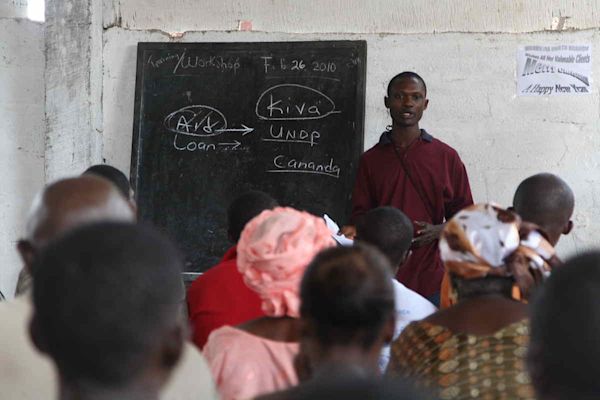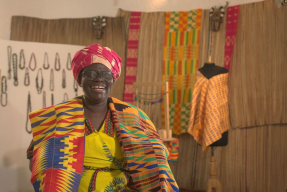
By John Briggs, KF10, Liberia
In Liberia, D-Day is a regular occurrence. Disbursal Day, that is.
Liberia, a small West African country whose brutal civil conflicts made large headlines for years, is now a peaceful place. Its people are brimming with optimism and energy, and its fertile land is blessed with stunning beaches, renowned surf, and rain forests teeming with wildlife.
Under the leadership of Ellen Johnson Sirleaf, Africa’s first elected female president, institutions and infrastructure destroyed during the wars are being rebuilt. Thousands of UN peacekeepers still roam the country, a large contingent of women among them, and armies of aid and development workers are also here.
Microfinance is a key part of the post-conflict recovery, and LEAP, Kiva’s Liberian field partner, is at the forefront. LEAP (the Local Enterprise Assistance Program) is Liberia’s oldest continuously operating microfinance lender, and the largest by number of borrowers and amount lent.
LEAP is my fourth assignment as a Kiva Fellow. Each posting has brought unique challenges and rewards, and has taught me much about how microfinance operates in a variety of contexts. The constant in my work, of course, has been Kiva — wherever you’re sent as a Fellow, the Kiva playbook is similar.
In Cambodia, the MFI I worked with only made loans to individuals. In the Philippines and Kenya, the MFIs I spent time at mostly made loans to borrowers bound by group guarantees, but for good logistical reasons — staggered disbursement times within groups was one, Kiva’s group loan limits was another — chose to post their borrowers to Kiva as individuals.
LEAP makes most of its loans to groups of five people. Everyone in these groups receives their money at the same time, and the group loan sizes easily fit within Kiva’s limits, so LEAP has chosen to post most of its borrowers to Kiva as groups.
(At present, Kiva’s group loans accommodate up to 50 borrowers with a maximum loan size of $5,000; group loans on Kiva may not average more than $400 per borrower, which means LEAP’s group loans can be up to $2,000 in size.)
Photos (and video) of borrowers are crucial to forming the “person-to-person” connection that Kiva helps facilitate. Analysis has shown that the content and quality of borrower images has an impact on the time it takes for a loan to fund.
Lenders open their hearts and wallets faster to smiling borrowers, and colorful, evocative photos are a further catalyst. This bias is predictable, but unfortunate — what if borrowers don’t have anything to smile about, or if their culture dictates serious faces when photos are taken, or if they don’t fit with the idea of what poverty should “look like”?
Group photos can pose a steep challenge for many of Kiva’s field partners — they simply don’t evoke the same response on the part of lenders that photos of individuals do. With photos of individuals, it’s easier for lenders get an instant sense of who borrowers are, and often, what the borrower’s business is.
Group photos tend to be taken at an MFI’s office, or at the place where the group meets, and often have an awkward feel to them. They lose the color and context that images of individuals at their workplace or home more easily convey.
At LEAP, this is especially true. Photos of groups are taken on disbursal days at branches or satellite offices. Disbursal days are complex affairs, where throngs of borrowers show up to claim their loan money.
Liberia is hot, and LEAP’s offices are not air conditioned. Orchestration of disbursals can take hours, and when photos and information for Kiva is gathered, it further complicates things.
Disbursal days are not the ideal environment in which to ask people for their photos and to sit for interviews, but LEAP borrowers are amazingly patient — once Kiva has been explained to them, they overwhelmingly consent to the process.
As the photos of LEAP’s borrower groups that make it to Kiva are woefully inadequate in conveying a sense of place, and often personality, I’d like to share with you the backstory of what really happened on one D-Day in February at a LEAP branch.

As borrowers wait downstairs, the action moves upstairs. Kiva Fellow Karen Buxton and LEAP staff prepare for the disbursal.

Groups of borrowers are called for photos. If all borrowers in a group agree, their photo is taken for Kiva. They can also decline to be on Kiva and still get their loans from LEAP. This group is named Grace of God.

Group leader Alieu Kamara signs a photo waiver and consent form, and LEAP Kiva Coordinator Tejan starts the Kiva business profile interview.

The interview takes about 10 minutes in all. Alieu's story will be featured in Grace of God's group profile on Kiva.

Grace of God is called for their disbursal. As the group leader, Alieu is responsible for receiving the money and handing it over to fellow members of the group.

Alieu is the last to receive his money. Each group member got the equivalent of less than $100 U.S., but since LEAP disburses using small-denomination Liberian bills, the piles of cash seem big. The exchange rate is roughly 70 Liberian dollars to $1 U.S.

Members of the group count their loan money to make sure they've received the correct amount. Disbursal day for Grace of God is finished, with a total elapsed time of about two hours.

Within a couple of weeks, the loan is listed on Kiva for funding. As the loan was pre-disbursed, Kiva lenders will backfill the loan, which will be repaid over a four-month term.
While photos of borrower groups can face a handicap on Kiva, the multitude of compelling images on Kiva has become the stuff of lore. Explore the thematic and educational photo galleries compiled by Kiva Friends.
Join the Kiva lending group Team LEAP – Liberia today!
PREVIOUS ARTICLE
I am here to confiscate your property →NEXT ARTICLE
Scaling in a Saturated Market: The Kenyan Experience →





















